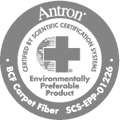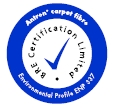 Being 100% environmentally friendly is hard…
Being 100% environmentally friendly is hard…
…but we all try, so the same applies at International Floorcoverings. We are trying to be as Environmentally friendly as possible. Our policy is; “what ever can be recycled generally is”. Instead of disposing of the clean off cut waste material from our projects, we recycle it to make the sampling that we give away. Whenever the need arises to use adhesives, we do our best to use Eco friendly adhesives that are extremely low TVOC (total volatile organic compounds) and give out low odour. We even go to the point of re using the cardboard and plastic tubing that the large new rolls of carpet are rolled on as well as the plastic wrapping that these large rolls of carpet are covered in.
Our entire range of woven carpets are Environmentally friendly. Our natural fibre carpets, including wool, sisal, jute, seagrass and coir are made from renewable or plentiful resources, are low in embodied energy and pollution impacts, also the dyes used are acid free and conform with all European standards.
No pesticides or chemical fertilizers are used in sisal production, and although herbicides are occasionally used, even this impact may be eliminated, since most weeding is done by hand.
Allergy problems are lessened because both coir and sisal contain tannins which repel dust mites. They also absorb moisture from the air when it’s humid and release it when the humidity drops, which helps stabilise the surroundings for sensitive noses.
When looking at flooring for your particular project, choose products with very low or no solvent and harmful particle emissions, such as Coir and Sisal which are non-toxic, antistatic and antibacterial. These environmentally friendly characteristics are making our natural fibre carpets increasingly popular with the Australian consumer.
What is Sisal? (Agave sisalana)
Sisal
A coarse and strong fibre, sisal is being increasingly used in composite materials for cars, furniture and construction as well as in plastics and paper products.
The plant
Sisal fibres are obtained from Agave Sisalana, a native of Mexico. The hardy plant grows well all year round in hot climate and arid regions which are often unsuitable for other crops. Sisal can be cultivated in most soil types except clay and has low tolerance to very moist and saline soil conditions. Husbandry is relatively simple as it is resilient to disease and its input requirement is low compared to other crops. Sisal can be harvested from 2 years after planting and its productive life can reach up to 12 years, producing from 180 to 240 leaves depending on location, altitude, level of rainfall and variety of plant.
The Fibre’s
Although the leaves contain about 90 percent moisture, they are rigid and the fleshy pulp is very firm. The fibres which lie embedded longitudinally in the leaves, being most abundant near the leaf surfaces, must be removed from the leaves as soon as they are cut in order to avoid the risk of damage during the cleaning process. Fibre removal is accomplished by scraping away the pulpy material, generally by a mechanical decortication process, and by hand stripping. Sisal is produced with minimum pre and post harvest losses and average yield of dried fibres is about 1 tonne per hectare, although yields in East Africa can reach 4 tonnes per hectare.
Environmental benefits
Sisal is a renewable resource par excellence and can form part of the overall solution to climate change. Measured over its life-cycle, sisal absorbs more carbon dioxide than it produces. During processing, it generates mainly organic wastes and leaf residues that can be used to generate bioenergy, produce animal feed, fertiliser and ecological housing materialand, at the end of its life cycle, sisal is 100 percent biodegradable. By contrast synthetically produced fibres do not possess any of these traits. Moreover sisal plants reduce soil erosion through its extensive root system and contributes positively to watershed management. Sisal plants used as hedges act as effective vegetative barriers/ fences to protect the crops lands and forests from predatory animals and intruders.
Environmental benefits
Sisal is a renewable resource par excellence and can form part of the overall solution to climate change. Measured over its life-cycle, sisal absorbs more carbon dioxide than it produces. During processing, it generates mainly organic wastes and leaf residues that can be used to generate bioenergy, produce animal feed, fertiliser and ecological housing materialand, at the end of its life cycle, sisal is 100 percent biodegradable. By contrast synthetically produced fibres do not possess any of these traits. Moreover sisal plants reduce soil erosion through its extensive root system and contributes positively to watershed management. Sisal plants used as hedges act as effective vegetative barriers/ fences to protect the crops lands and forests from predatory animals and intruders.
Even Our Woven Antron is an Environmental Green Label Fibre
Woven Platinum Antron® 6.6 Nylon fibre commercial carpet comes with the green tick of approval, this is due to the fibre being recyclable, the energy used for manufacturing the Antron® fibre is 30% lower than the European benchmark. Added to this is the durability of the product, lasting longer on the floor, lessens the need to replace it as often as other commercial carpet.
Woven Antron Excel Fibre is Certified by Scientific Certification System as an Environmentally Preferred Product
Woven Antron Excel Fibre holds a CRI Green Label Plus (USA) GLP 7478 rating for indoor air quality with VOC’s of less than 0.5mg/sq hr


Woven Antron Excel fibre is a renewable resource
